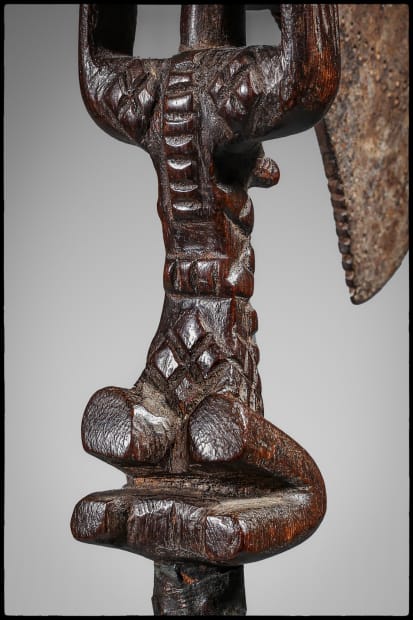-

-
Emblème de pouvoir, cette hache d’apparat appartenait à un important chef
Kalundwe de la région des Luba occidentaux.
Elle symbolise les origines de la royauté Luba dont le héros culturel, Mbidi
Kiluwe, introduisit les techniques de métallurgie.
This ceremonial axe was a symbol of power. It belonged to an important Kalundwe chief in the western Luba region.
It symbolizes the origins of Luba royalty, whose cultural hero, Mbidi Kiluwe, introduced the techniques of metallurgy. -

-

-
La représentation de la femme est centrale dans l’art Luba car seul le corps féminin est assez fort pour abriter un esprit puissant et notamment les esprits des rois défunts. De plus, les femmes jouent un rôle majeur dans la vie politique.
The representation of women is central to Luba art, as the female body is believed to be the only vessel strong enough to house a powerful spirit, particularly those of deceased kings. Women also play a major role in political life.
-

-

-

-

Hache d’apparat Luba, Kalundwe.
République Démocratique du Congo
48,5 cm
19ème siècle
Provenance: Collection du peintre belge Constant Permeke (1886 - 1952)
Transmit par descendance.
Didier Claes.
Collection Richard Carchon, acquis de ce dernier en 2011.Publications: « Empreintes d’Afrique, L’Art Tribal au fil des fleuves », Bettina
Von Linting, Editions 5 Continents, 2011.
« Fétiches et objets ancestraux d’Afrique », François Neyt,
Editions 5 Continents, 2013.
Luba ceremonial axe, Kalundwe.
Democratic Republic of the Congo
48.5 cm
19th century
Provenance: Collection of Belgian painter Constant Permeke (1886 - 1952)
Transmitted by descent.
Didier Claes.
Collection Richard Carchon, acquired from the above in 2011.Publications: « Empreintes d’Afrique, L’Art Tribal au fil des fleuves », Bettina
Von Linting, Editions 5 Continents, 2011.
« Fétiches et objets ancestraux d’Afrique », François Neyt,
Editions 5 Continents, 2013.








